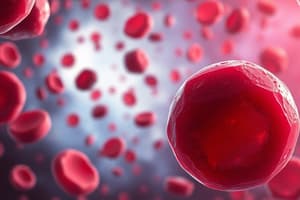Podcast
Questions and Answers
What percentage of whole blood is primarily made up of plasma?
What percentage of whole blood is primarily made up of plasma?
- 60%
- 50%
- 45%
- 55% (correct)
Which of the following elements are included in the formed elements of blood?
Which of the following elements are included in the formed elements of blood?
- Erythrocytes, leukocytes, and platelets (correct)
- Leukocytes and platelets
- Erythrocytes and myocytes
- Neurons and leukocytes
What is the term used to describe the percentage of red blood cells in the total blood volume?
What is the term used to describe the percentage of red blood cells in the total blood volume?
- Hemoglobin concentration
- Platelet volume
- Leukocyte count
- Hematocrit (correct)
What is the composition of the buffy coat in whole blood?
What is the composition of the buffy coat in whole blood?
What is the main function of erythrocytes in the blood?
What is the main function of erythrocytes in the blood?
What is the primary role of platelets in blood?
What is the primary role of platelets in blood?
Leukocytes are primarily responsible for the transport of oxygen in the blood.
Leukocytes are primarily responsible for the transport of oxygen in the blood.
What percentage of whole blood is made up of formed elements?
What percentage of whole blood is made up of formed elements?
The liquid portion of blood, making up about 55% of its total volume, is called __________.
The liquid portion of blood, making up about 55% of its total volume, is called __________.
Match each type of formed element with its function:
Match each type of formed element with its function:
What percentage of whole blood is represented by the buffy coat?
What percentage of whole blood is represented by the buffy coat?
Erythrocytes are also known as platelets.
Erythrocytes are also known as platelets.
What are the main components of blood?
What are the main components of blood?
Blood is the body’s only _____ tissue.
Blood is the body’s only _____ tissue.
What shape do Erythrocytes take?
What shape do Erythrocytes take?
What is the importance of erythrocytes biconcave shape?
What is the importance of erythrocytes biconcave shape?
What is diapedesis?
What is diapedesis?
Match the blood function to it's description.
Match the blood function to it's description.
Match the Leukocyte cell type to it's function.
Match the Leukocyte cell type to it's function.
Flashcards
Blood composition
Blood composition
Blood is a fluid tissue composed of plasma and formed elements.
Plasma
Plasma
The liquid portion of blood, making up about 55% of whole blood.
Formed elements
Formed elements
Solid parts of blood, including red blood cells, white blood cells, and platelets.
Erythrocytes
Erythrocytes
Signup and view all the flashcards
Leukocytes
Leukocytes
Signup and view all the flashcards
Platelets
Platelets
Signup and view all the flashcards
Hematocrit
Hematocrit
Signup and view all the flashcards
Buffy coat
Buffy coat
Signup and view all the flashcards
Blood Composition
Blood Composition
Signup and view all the flashcards
Plasma
Plasma
Signup and view all the flashcards
Formed Elements
Formed Elements
Signup and view all the flashcards
Red Blood Cells (RBCs)
Red Blood Cells (RBCs)
Signup and view all the flashcards
White Blood Cells (WBCs)
White Blood Cells (WBCs)
Signup and view all the flashcards
Platelets
Platelets
Signup and view all the flashcards
Hematocrit
Hematocrit
Signup and view all the flashcards
Buffy Coat
Buffy Coat
Signup and view all the flashcards
Blood Composition
Blood Composition
Signup and view all the flashcards
Plasma
Plasma
Signup and view all the flashcards
Formed Elements
Formed Elements
Signup and view all the flashcards
Red Blood Cells (RBCs)
Red Blood Cells (RBCs)
Signup and view all the flashcards
White Blood Cells (WBCs)
White Blood Cells (WBCs)
Signup and view all the flashcards
Platelets
Platelets
Signup and view all the flashcards
Hematocrit
Hematocrit
Signup and view all the flashcards
Buffy Coat
Buffy Coat
Signup and view all the flashcards
Study Notes
Blood Composition
- Blood is the body's only fluid tissue
- Composed of liquid plasma and formed elements
- Formed elements include:
- Erythrocytes (red blood cells, RBCs)
- Leukocytes (white blood cells, WBCs)
- Platelets
- Hematocrit: percentage of RBCs in total blood volume
Components of Whole Blood
- Plasma (55%): liquid portion of blood
- Buffy coat (<1%): leukocytes and platelets
- Formed elements (45%): erythrocytes
Blood Functions
- Substance distribution
- Regulation of blood levels of substances
- Body protection
Erythrocytes (RBCs)
- Biconcave discs, anucleate, no organelles
- Filled with hemoglobin (Hb): gas transport protein
- Contain plasma membrane protein spectrin and other proteins for flexibility and shape change
- Have a large surface area relative to volume
- Facilitates gas transport
Structure of Hemoglobin
- Complex protein with iron-containing heme groups
- Essential for oxygen transport
Leukocytes (WBCs)
- Complete cells, less numerous than RBCs
- Constitute 1% of total blood volume
- Diapedesis: ability to leave capillaries and move through tissue spaces
- Leukocytosis: WBC count over 11,000 per cubic millimeter (normal response to infection)
Granulocytes
- Neutrophils, eosinophils, basophils
- Contain cytoplasmic granules (stain with Wright's stain)
- Larger and shorter-lived than RBCs
- Lobe nuclei
- Phagocytic cells: engulf and destroy foreign material
Summary of Formed Elements
- Table details cell type, description, cells/mm³, development duration, and function for erythrocytes, leukocytes (granulocytes & agranulocytes), and platelets
Studying That Suits You
Use AI to generate personalized quizzes and flashcards to suit your learning preferences.




